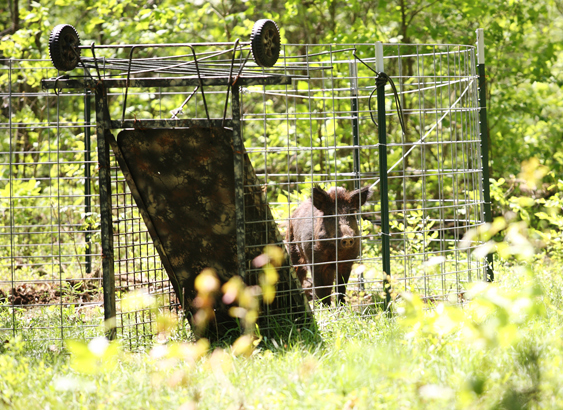By Art Lander Jr
FRANKFORT, Ky. – In Kentucky, wild pigs may be hunted with firearms year-round with no daily bag limit, but wildlife biologists believe trapping is the most effective way to control the feral pests.
“In established populations, hunting often educates more pigs than it removes,” said Chad Soard, a wildlife biologist with the Kentucky Department of Fish and Wildlife Resources. “Research has shown that relying too heavily on hunting will not control pigs and may hasten their spread.”

Kentucky Fish and Wildlife is working with landowners to help them deal with the destructive, unwanted swine which pose serious ecological, economic and disease threats.
“We’ve had verified sightings of wild pigs in 37 counties,” said Soard. “For many of these sightings there’s no evidence of established populations. They’re just isolated occurrences of free-ranging pigs living independent of humans.”
Soard said he gets regular reports from landowners about their ongoing efforts to remove pigs from areas of Kentucky with established populations. “You have to adapt your strategy to completely eradicate wild pigs,” said Soard. “You have to understand the species. Shooting them on sight isn’t always best.”
Wild pigs live in maternal groups called sounders, usually made up of several related sows with their offspring. Several maternal groups may come together to forage so there could be as many as 20 to 30 pigs on a food source.
Mature boars tend to be solitary and don’t tolerate the presence of other males.
Hunting in general, and sport hunting in particular, is ineffective for controlling or eradicating wild pigs because boars are targeted.
“The removal of all age classes concurrently is critical to any successful control or eradication plan,” said Soard. “Reproduction often outpaces the most intensive hunting efforts. Juveniles can breed at six months so you have to concentrate your efforts on maternal groups, continually trapping over a long period of time.”
Shooting into a group of pigs forces them to search for sanctuary. “You’re going to spread out the population and push them onto neighboring properties,” said Soard.
“Wild pigs are not prone to wandering. They’re not overly territorial, except when boars are fighting over breeding rights,” said Soard. “Populations tend to stay in a small area unless they are pressured.”
Wild pigs make their presence known by the sign they leave such as rooted up areas in woods and fields and wallows around small ponds or wet areas.
Trail cameras are a good way to assess wild pig numbers and find suitable trap sites. “You can’t just trap anywhere; you have to locate the trap on fresh sign, where the pigs are actively feeding or traveling,” said Soard.
Large box traps can be used to catch wild pigs, but corral traps are better. “They allow non-targeted species to escape and are capable of catching entire maternal groups of pigs at one time,” said Soard.
Corral traps are made from wire and typically have a swinging, saloon-style gate which lets the pigs enter, but blocks them from leaving the trap. A good strategy is to establish the trap site at an area where pigs can feed unmolested. Then, monitor the site with trail cameras and set the trap when the largest numbers of pigs are feeding at the site.
In Kentucky, it is illegal to possess wild pigs. Any captured pig must be killed at the trap site. They may not be removed from traps alive.
Corral traps are commercially available or can be homemade. “We have a cost share program to help landowners offset the cost of the traps,” said Soard.
Winter is the best time to trap. Food is in short supply and pigs readily come to bait piles. The best trap sites for pigs are located along travel routes between bedding and feeding sites.
Trapping works. “The staff at Bernheim Forest corral trapped steadily for three years and reduced the population to the point where damage and observations have ceased,” said Soard. “You can’t trap for a while and quit. You’ve got to stick with it.”
Media Contact: Art Lander Jr 1-800-858-1549, ext. 4414


I just could not go away your web site before suggesting that I really loved the usual information an individual supply on your guests? Is gonna be again steadily in order to check up on new posts